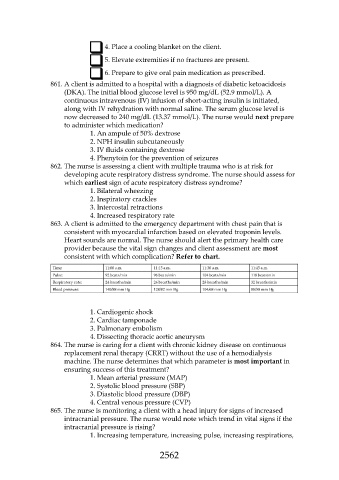Page 2562 - Saunders Comprehensive Review For NCLEX-RN
P. 2562
4. Place a cooling blanket on the client.
5. Elevate extremities if no fractures are present.
6. Prepare to give oral pain medication as prescribed.
861. A client is admitted to a hospital with a diagnosis of diabetic ketoacidosis
(DKA). The initial blood glucose level is 950 mg/dL (52.9 mmol/L). A
continuous intravenous (IV) infusion of short-acting insulin is initiated,
along with IV rehydration with normal saline. The serum glucose level is
now decreased to 240 mg/dL (13.37 mmol/L). The nurse would next prepare
to administer which medication?
1. An ampule of 50% dextrose
2. NPH insulin subcutaneously
3. IV fluids containing dextrose
4. Phenytoin for the prevention of seizures
862. The nurse is assessing a client with multiple trauma who is at risk for
developing acute respiratory distress syndrome. The nurse should assess for
which earliest sign of acute respiratory distress syndrome?
1. Bilateral wheezing
2. Inspiratory crackles
3. Intercostal retractions
4. Increased respiratory rate
863. A client is admitted to the emergency department with chest pain that is
consistent with myocardial infarction based on elevated troponin levels.
Heart sounds are normal. The nurse should alert the primary health care
provider because the vital sign changes and client assessment are most
consistent with which complication? Refer to chart.
1. Cardiogenic shock
2. Cardiac tamponade
3. Pulmonary embolism
4. Dissecting thoracic aortic aneurysm
864. The nurse is caring for a client with chronic kidney disease on continuous
replacement renal therapy (CRRT) without the use of a hemodialysis
machine. The nurse determines that which parameter is most important in
ensuring success of this treatment?
1. Mean arterial pressure (MAP)
2. Systolic blood pressure (SBP)
3. Diastolic blood pressure (DBP)
4. Central venous pressure (CVP)
865. The nurse is monitoring a client with a head injury for signs of increased
intracranial pressure. The nurse would note which trend in vital signs if the
intracranial pressure is rising?
1. Increasing temperature, increasing pulse, increasing respirations,
2562

